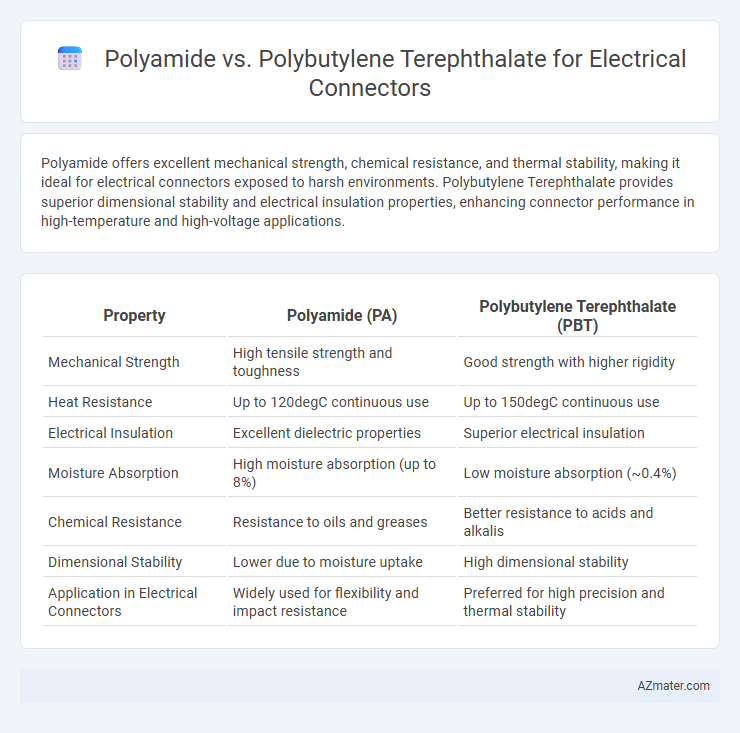Polyamide offers excellent mechanical strength, chemical resistance, and thermal stability, making it ideal for electrical connectors exposed to harsh environments. Polybutylene Terephthalate provides superior dimensional stability and electrical insulation properties, enhancing connector performance in high-temperature and high-voltage applications.
Table of Comparison
| Property | Polyamide (PA) | Polybutylene Terephthalate (PBT) |
|---|---|---|
| Mechanical Strength | High tensile strength and toughness | Good strength with higher rigidity |
| Heat Resistance | Up to 120degC continuous use | Up to 150degC continuous use |
| Electrical Insulation | Excellent dielectric properties | Superior electrical insulation |
| Moisture Absorption | High moisture absorption (up to 8%) | Low moisture absorption (~0.4%) |
| Chemical Resistance | Resistance to oils and greases | Better resistance to acids and alkalis |
| Dimensional Stability | Lower due to moisture uptake | High dimensional stability |
| Application in Electrical Connectors | Widely used for flexibility and impact resistance | Preferred for high precision and thermal stability |
Introduction to Polyamide and Polybutylene Terephthalate
Polyamide (PA), commonly known as nylon, is a versatile thermoplastic with excellent mechanical strength, thermal resistance, and electrical insulation properties, making it a popular choice for electrical connectors. Polybutylene Terephthalate (PBT) is a crystalline polyester known for its high dimensional stability, chemical resistance, and good electrical insulating capabilities, often used in harsh environments for connectors. Both materials offer unique advantages in electrical connector applications, where durability and performance under electrical stress are critical factors.
Chemical Structure and Composition Comparison
Polyamide (PA) features a linear polymer chain with repeating amide groups (-CONH-) that provide excellent mechanical strength and thermal resistance, making it suitable for high-performance electrical connectors. Polybutylene terephthalate (PBT) is a semi-crystalline polyester composed of butylene glycol and terephthalic acid units, offering superior chemical resistance, dimensional stability, and electrical insulation properties. The amide linkages in polyamide contribute to hydrogen bonding and toughness, whereas the ester linkages in PBT result in lower water absorption and enhanced resistance to environmental stress cracking in connector applications.
Mechanical Properties: Strength and Flexibility
Polyamide (PA) offers high tensile strength and excellent flexibility, making it ideal for electrical connectors requiring durability and resistance to mechanical stress. Polybutylene Terephthalate (PBT) provides superior dimensional stability and rigidity, with moderate strength but less flexibility compared to polyamide. Selecting between PA and PBT depends on application needs: polyamide supports impact resistance and bending, while PBT excels in maintaining shape under heat and mechanical load.
Thermal Stability and Heat Resistance
Polybutylene Terephthalate (PBT) offers superior thermal stability and heat resistance compared to Polyamide (PA), with a higher melting point around 225degC versus 215degC for typical nylon variants. PBT maintains dimensional stability under continuous exposure to temperatures up to 150degC, making it ideal for electrical connectors subjected to prolonged thermal stress. Polyamide, while offering good mechanical strength, tends to absorb moisture, which can negatively impact its heat resistance and long-term thermal performance in high-temperature applications.
Electrical Insulation Capabilities
Polyamide (PA) offers excellent electrical insulation properties with high dielectric strength and low moisture absorption, making it highly reliable for electrical connectors in demanding environments. Polybutylene Terephthalate (PBT) also provides strong electrical insulation but exhibits superior dimensional stability and resistance to heat and chemicals, which enhances connector performance under thermal stress. While both materials are widely used, PA is often preferred for its better insulation in humid conditions, whereas PBT excels in applications requiring higher thermal endurance and mechanical robustness.
Moisture Absorption and Dimensional Stability
Polyamide exhibits higher moisture absorption, typically around 2-3%, leading to potential dimensional changes in electrical connectors, while Polybutylene Terephthalate (PBT) absorbs less moisture, generally below 0.4%, ensuring superior dimensional stability. The low moisture uptake of PBT reduces the risk of swelling and deformation, critical for maintaining connector integrity in humid environments. Consequently, PBT is often preferred in applications requiring consistent mechanical and electrical performance under varying humidity conditions.
Processability in Electrical Connector Manufacturing
Polyamide offers excellent processability in electrical connector manufacturing due to its high melt viscosity, which provides superior flow control and precision molding. Polybutylene Terephthalate (PBT) features lower melt viscosity, enabling faster cycle times and easier injection molding but may require more precise temperature control to avoid degradation. Both materials exhibit good dimensional stability, yet Polyamide's broader thermal processing window enhances its adaptability for complex connector geometries.
Cost Efficiency and Material Availability
Polyamide offers cost efficiency due to its widespread availability and lower raw material costs in electrical connector manufacturing, making it a budget-friendly choice for high-volume production. Polybutylene Terephthalate (PBT) provides superior dimensional stability and chemical resistance but often comes at a higher price and limited supply compared to polyamide. Manufacturers balance cost efficiency and performance requirements by selecting polyamide for economical large-scale applications, while opting for PBT when enhanced durability and thermal properties justify the additional expense.
Application Suitability: Real-World Use Cases
Polyamide (PA) is widely used in electrical connectors due to its excellent mechanical strength, chemical resistance, and thermal stability, making it ideal for automotive and industrial applications where durability under harsh conditions is critical. Polybutylene Terephthalate (PBT) offers superior dimensional stability and electrical insulation properties, favored in consumer electronics and telecommunication connectors where precision and performance consistency are essential. Real-world use cases show PA connectors excel in environments exposed to vibration and high temperatures, while PBT is preferred for high-frequency electrical applications requiring low moisture absorption and flame retardancy.
Environmental Impact and Sustainability Considerations
Polyamide (PA) and Polybutylene Terephthalate (PBT) differ significantly in environmental impact and sustainability for electrical connectors. PA is derived from petroleum-based sources and is less biodegradable, raising concerns about long-term environmental persistence, whereas PBT offers better recyclability properties and lower greenhouse gas emissions during production. PBT's enhanced resistance to chemicals and heat also contributes to longer product life cycles, reducing waste and supporting sustainability in electrical connector applications.

Infographic: Polyamide vs Polybutylene Terephthalate for Electrical Connector
 azmater.com
azmater.com